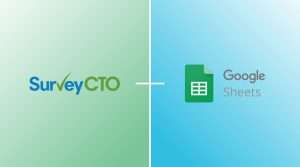Have you ever needed to know exactly what is happening during data collection occurring thousands of miles away? Do you find yourself backtracking and spending hours tirelessly correcting poor or fake data after the collection phase of a study has wrapped up? Or have you ever had mobile devices lost or stolen in the field that resulted in loss of critical and highly sensitive data?
SurveyCTO provides solutions to all of these scenarios – and more! – in a variety of ways you may not even be aware of. Below are 11 things you never knew the platform could do to save you time and provide quality, secure data for any kind of data collection project.
Need to know where surveys were done but don’t want to rely on surveyors to capture GPS coordinates themselves?
Capture GPS locations of surveys automatically and invisibly in the background, without having to prompt surveyors to do so. Just use the ‘background’ appearance for any geopoint field you create in your form. If you put this field toward the middle or the start of the last third of your form it will give the field enough time to lock onto a GPS location, but not so much time that it uses up too much battery power. Read the documentation topic.
Pre-warm your GPS sensor for faster and more accurate GPS capture
Have you ever been out in the field, wasting time waiting for your tablet’s GPS chip to lock onto your location? GPS locations are really important, but shouldn’t hold up the show. Use SurveyCTO Collect’s GPS chip “pre-warming” advanced feature to get your device working on an accurate location before you need it. That way, your team will be on their way to their next location in no time.
Encrypt forms using your own encryption keys
Keep your IRB happy by encrypting your data using your own encryption keys, so that it is “zero knowledge” hosted. Enable SurveyCTO’s 2048-bit private/public encryption keys so your data is safe in transit and at rest. At rest encryption ensures that in the unfortunate event of a lost or stolen tablet, your data is protected. Follow the step-by-step guide in this documentation topic to use this feature in your next data collection project.
More easily manage multiple team logins with single sign-on (SSO)
Single sign-on (SSO) is a property which allows a user to use a single login (i.e. username and password) to access multiple applications, using third party authentication services, like Google, Okta, or Microsoft Azure AD. By linking your SurveyCTO account to your chosen SSO system via your server console, the whole team – global administrator to data collector – can sign into SurveyCTO easily using SSO. This allows you to much more easily manage multiple logins of team members who may be regularly changing over the lifetime of a project. When a team member leaves the organization, and the overall organization login is revoked, that user loses access to SurveyCTO as well. In addition to being an important security feature, SSO even eliminates the need of you and your team to remember and save new passwords. Read the documentation here.
Download our Stata .do file to save valuable hours
Stata user? Take minutes, not hours, to import and label your exported data in Stata by downloading a pre-created .do file for your form definition. Next to your form title on the Design tab of the server console, click “downloads” and then “Stata .do file”. Download a .do file for either importing your data in long format or wide format – whichever you prefer.
Use sensor metadata fields to gain important insights about submissions
If your data collection projects are occurring across the world, each insight you can gain about the survey administration process is essential in improving the quality of your data. And it helps catch issues early on with time for course correction. SurveyCTO allows you to collect sensor metadata to help you determine, for example, if a conversation is taking place while your form is open, or if your interviews are happening indoors or outdoors. Read more in the documentation.
Protect forms and data by restricting which users can access which forms on your server using SurveyCTO’s “teams” feature
Controlling access to your forms and datasets is not only necessary to organize your projects, but it also keeps your data secure. With SurveyCTO’s ”teams” feature, you can have a single, flexible subscription which allows you to silo user access to forms and data according to your project cycles, budget, and even IRB requirements by creating separate spaces for separate teams or projects. With console wizards, adding and removing teams is a quick and painless process.
Have your server automatically detect errors in surveys by configuring automated statistical/quality checks
Catching suspicious data is not only difficult, but it is extremely time sensitive. Even a few submissions with improperly collected data can cause frustration and cost you and your team significant time and money. But without deep technical expertise to produce complex statistical checks in tools like Stata or R, it can be almost impossible to run the necessary checks to catch certain problems in your data. SurveyCTO’s built-in quality checks automatically run statistical checks that would otherwise take hours or days to set up, flagging suspicious data so that you can detect and fix issues faster and avoid expensive re-administration of problematic surveys later on. And they just take a few, easy clicks to configure.
One place to explore and visualize all your external and survey form data
Juggling multiple platforms and data sets – whether it is raw form data or Stata output files – is not only time-intensive, but it can result in poorer quality data in the end. SurveyCTO allows you to merge external data with form data and visualize it all together in the Data Explorer. But that’s not all you can do with the Data Explorer. Learn more from our tutorial videos on monitoring here.
Spot check your surveys remotely by invisibly recording audio clips
As a project manager or lead, you can’t always be on the ground, collecting the tens, hundreds, or thousands of survey submissions for your study. Whether it is your team or a survey firm administering the surveys, the challenge is the same – lack of visibility into what is actually happening on the ground during a survey. By adding an audio audit field to your survey, you can use SurveyCTO to record portions of the survey and listen in to what was happening, as if you were standing right next to your data collector. Reviewing audio clips is not only a great way to catch issues and course correct in real-time but also a valuable way to give feedback to and train field enumerators!
Get super fast 24×7 support from field researchers and survey experts
Being a team of researchers, economists, and international development professionals who have spent decades collecting data all over the world, we know how important it is to get immediate assistance – no matter the day, hour, or time zone. Get 24×7, real-time help from one of our support and research team members with the click of a button (seriously, our team responds super fast). Try it out; you’ll see why users who do utilize the support team say it is the most valuable aspect of SurveyCTO (and the best support they’ve ever gotten).




